How to Help Your Cat’s Dry Skin


If you’ve ever had dry skin, you probably know the signs: Flaking, itchiness and general discomfort. Did you know cats can have this condition as well complete with the same symptoms?
If you’re wondering how to help your cat’s dry skin, the good news is there are several options. From controlling the humidity in your home to modifying the cat food you're serving them, there may be a simple solution you can try at home.
Your veterinarian can help you choose the best steps to take. They may also recommend a closer evaluation if they think dryness is a sign of an underlying health condition.
If your cat has dry skin, here’s some useful information and treatment tips that can provide them with relief.
Symptoms of Cat Dry Skin
The most common sign of cats with dry skin is scratching more than usual. They may also have dandruff, which looks like white or gray flecks on their coat. A greasy coat is sometimes associated with dry skin as well.
For comparison, healthy cat skin is clean and pliable, meaning you should be able to stretch it (gently). It isn’t excessively oily or dry, and it should be free of sores.
Causes of Dry Skin in Cats
The root cause of cats’ dry skin is abnormal or excessive shedding of skin cells (a.k.a. dander). This might occur for any of the following reasons:
- Dry air. When moisture decreases in the air (as is common during winter months), it evaporates from your cat’s skin more quickly.
- Poor diet. An imbalanced diet lacking in essential nutrients can lead to dry skin (among other health issues).
- Stress. Anxiety triggered by changes in the home, social circle or environment may tax your pet’s health.
- Allergies. Whether it’s caused by fleas, the environment or food, itchy, dry skin is a common symptom of allergies in cats.
- Other illnesses. Dry skin can be a sign of a more serious health condition such as diabetes or liver disease.
- Obesity: Extra weight on a cat can cause decreased range of motion, making it difficult to groom in certain places, which can lead to dry skin.
How to Help Your Cat’s Dry Skin: Treatment Options
Brush Daily
Brushing often with a slicker brush followed by combing with a metal comb is one of the most effective ways to help battle your cat’s dry skin.
Here’s why: As you brush, you distribute oil through the entire coat, release the dander and remove dead hair from the follicles, allowing the oil glands to work properly.
The combing will remove any matting and clumping your brush can’t.
Increase Humidity in Your Home
Indoor heating systems remove moisture from the air, which can lead to dry skin in both humans and cats. Humidifiers add moisture to the environment, however, helping to alleviate issues of dry skin. Put them in the room(s) in which your cat spends the most time.
Try a Diet Supplement
Adding more essential fatty acids during cold, dry months can help reduce dryness. These fatty acids play a huge part in promoting a healthy coat and supple skin.
Higher levels of fat and protein can also help. Just make sure to talk to your veterinarian before modifying your pet’s diet.
Lower Household Stress
Changes in environment or routine can cause your cat to become stressed, increasing their dry, flaky skin and shedding. Some small changes can help relieve that stress, however.
Confirming they have access to their litter box and water dish, increasing playtime and creating a more cat-friendly environment can all reduce anxiety.
Look for Other Signs of Infection
Remember, if your cat has dry skin, it can also be a sign of illness.
If they’re experiencing dryness in addition to other symptoms like rashes, sores, excessive grooming or other unusual signs or behavior, contact your veterinarian.
Consider Allergies
Like infections, allergies are usually accompanied by symptoms other than dry skin. If they appear at the same time, scratching, hair loss and digestive upset are just a few indications of a potential allergic reaction.
My Cat Has Dry Skin—Now What?
If your cat has dry skin, it’s a good idea to contact your veterinarian. They can help you figure out if it’s simply a reaction to dry air, cause for medical attention or another reason. They’ll also prescribe treatment based on your individual pet’s needs.
Want more health tips for your cat? Find out what our experts have to say on our Pet Expertise page.
Related articles

Earn myPurina Rewards with Every Purchase
Use your points for treats, toys, and gift cards with myPurina app.






